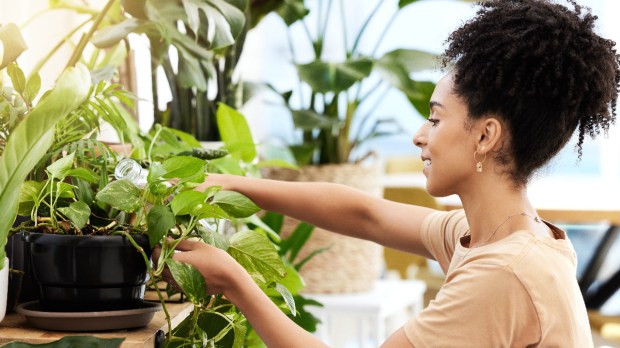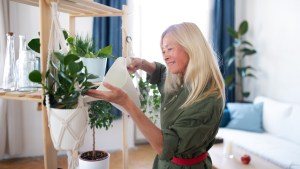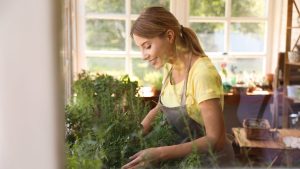Gardens played an important part in salvation history, from the Eden to Gethsemane. Monks and other Christians have long cherished gardens as places of nourishment and reflection. And Gregor Mendel conducted his research on heredity in the garden of the monastery in Brno, proving that gardens can also be places of learning and discovery.
Case in point: When my kids learned about photosynthesis recently, their little minds were blown.
“You mean plants eat what we breathe out? And they make what we breathe in? So plants are keeping us ALIVE?!”
Yes, indeed. My kids’ understanding of the whole process might be simplistic, but their awe made me stop to be amazed by it, too. It really is incredible how plants make it possible for us to live and breathe!
If you’ve ever felt like you can breathe easier on a walk through the forest, it’s not your imagination. Trees filter out germs and pollutants, making the air in forests cleaner and fresher than in other places.
Can you get these health benefits at home? It turns out you can, although in a smaller way, of course.
A recent study found that plants can efficiently remove toxic gasoline fumes, including cancer causing compounds such as benzene, from indoor air. “The bottom line is that the best, most cost effective and most sustainable way to combat harmful indoor air contaminants in your workplace and home is to introduce plants.”
Sign me up for cleaner air at home! Here’s how to get started.
Choose an indoor plant
There are a wide variety of plants that will do well indoors. You’ll be surprised how the addition of a few plants can change the air quality of your living space — while also providing a more comforting environment for prayer and reflection.
My personal pick would be to start with an herb, such as basil, so you can use it in cooking for even more health benefits. Basil is a hardy herb that grows extremely well both indoors and outdoors, so it’s a reliable choice even for those of us lacking a green thumb!
Here are some tips to help your basil plant thrive …
- Place your basil in a warm, sunny spot
- Keep the soil moist, giving at least an inch of water per week
- Pinch back leaves from the tips as soon as the plant has two sets of true leaves (you can cook with these leaves and they are delicious!)
- When harvesting, snip the stem just above the point where two large leaves meet
Health benefits
We already know that having a leafy plant like basil in your home will help you breathe easier and clean the air. But what about the benefits of eating it?
It turns out this fresh herb is super healthy! Having antioxidants and anti-bacterial properties, basil helps maintain skin health, boosts digestion and detoxifies the body. It also helps in the prevention and cure of diseases. Fresh basil contains Vitamin A, Vitamin K, Iron, Manganese, Calcium, and essential oils.
Where does the name come from?
While no one knows for sure, the name basil may be derived from the Greek words basileus meaning “king” or basilikon meaning “royal.” Sounds like a little reminder of God, our king!
Plants and toddlers
If you’ve got little ones around, you know indoor gardening can be tricky if your toddler tries to go digging in the dirt inside those terracotta pots. Our solution has been to put the plants up high on a shelf or window ledge to keep the plants visible but the toddlers away from them.
One last benefit
Basil plants improve air quality inside, and eating them is chock-full of benefits. But there’s one other little benefit to growing basil and other herbs inside your home.
Gardening and caring for plants is itself a way to boost your health:
For people experiencing the symptoms of mental illness, indoor gardening can be helpful … Horticultural therapy increases feelings of well-being among people with depression, anxiety, dementia, and other conditions … Medical clinics in Manchester, England are now “prescribing” potted plants to patients with depression or anxiety symptoms.
It’s no wonder so many people proudly claim the (tongue-in-cheek) label of “plant dad” or “plant mom.”
The more I learn about plants, the more awe I feel at God’s wondrous creation. I’m glad my kids clued me in, and I think it’s about time we added a few more plants to our indoor garden!



